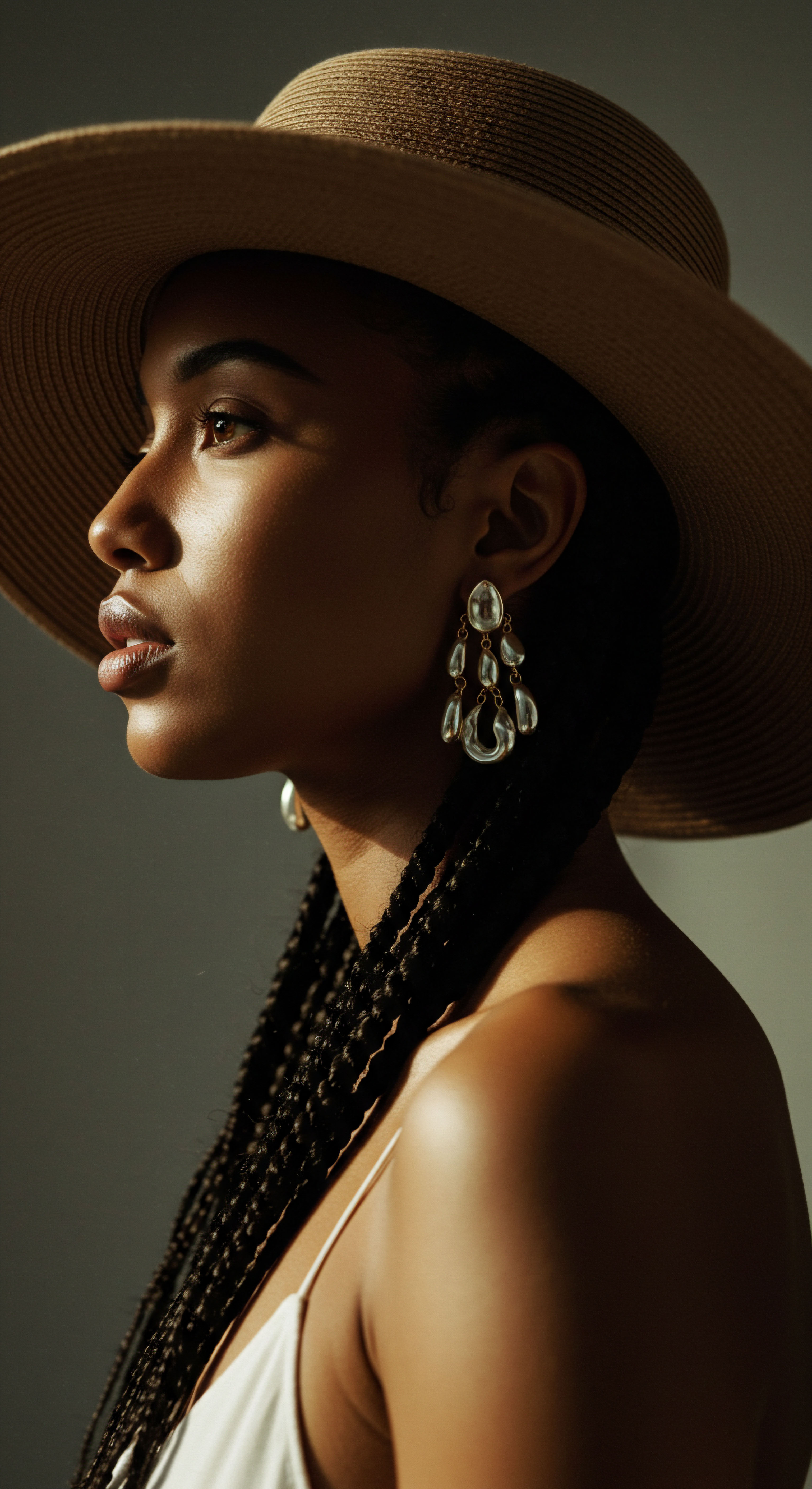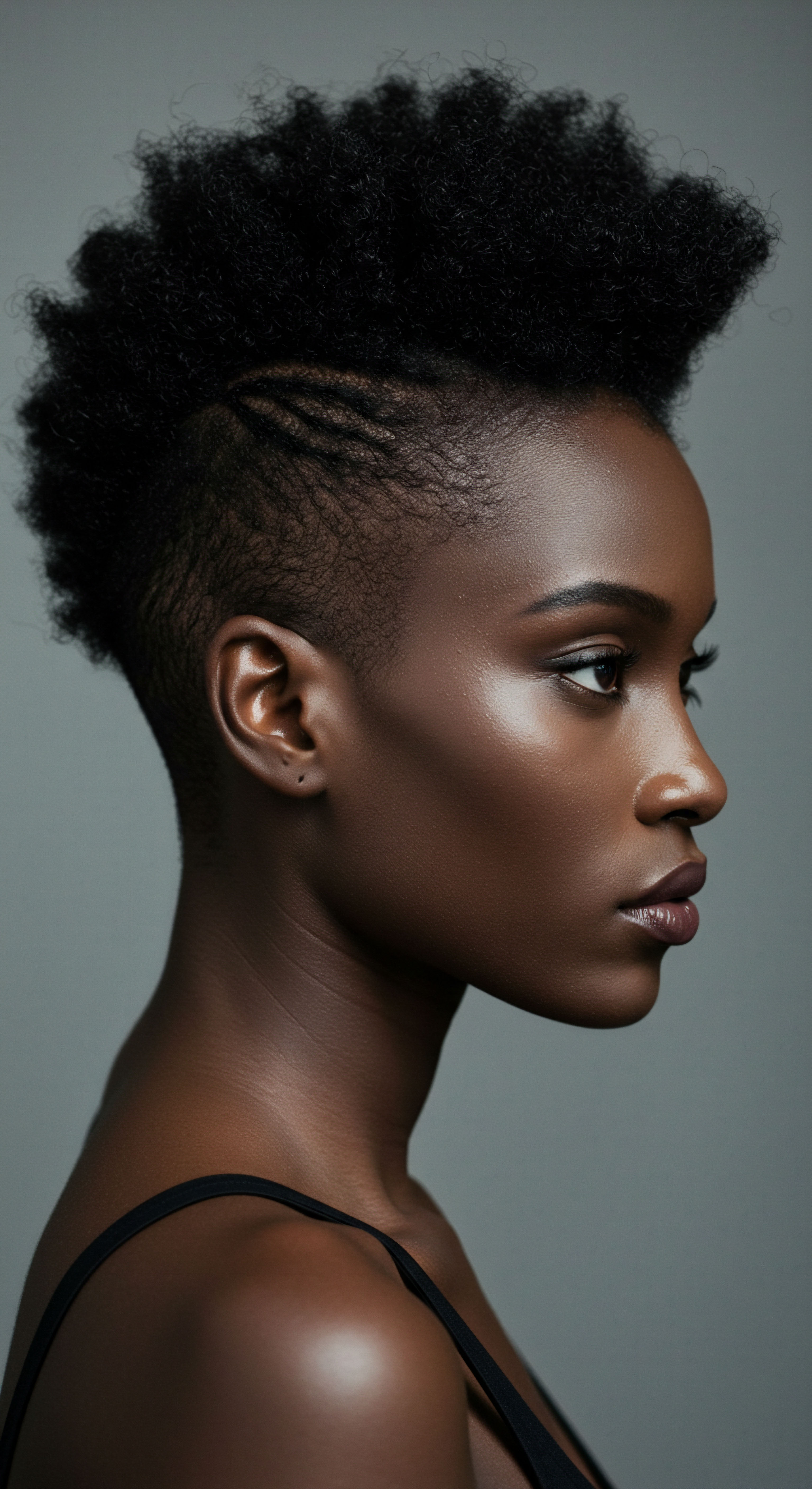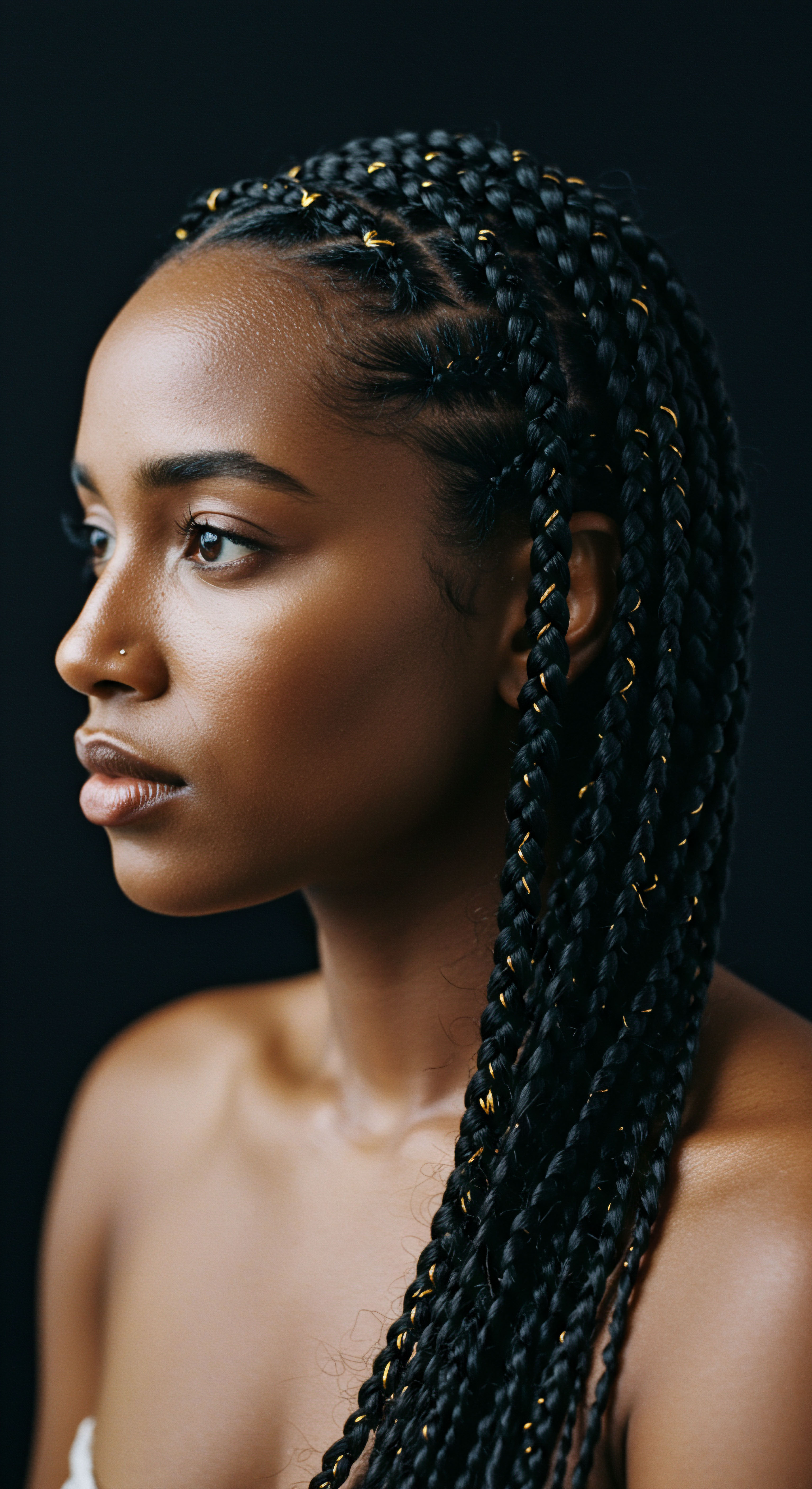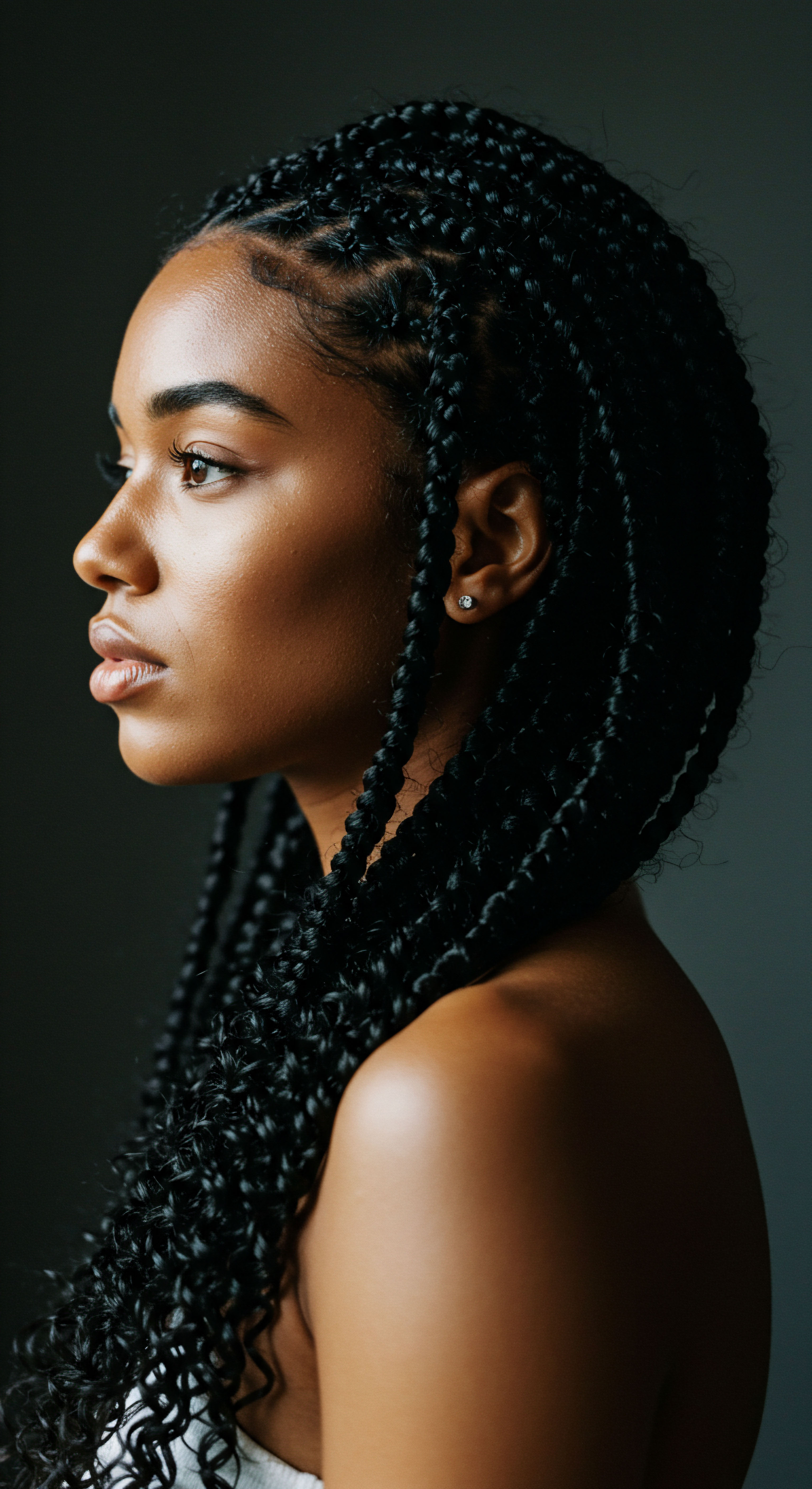
Roots
Consider the whispers carried on the desert wind, not of parched earth, but of resilience, of ancient secrets held within each strand. Our quest to understand how the people of Kemet, the Black Land, safeguarded their hair from the sun’s relentless embrace and the arid air’s constant thirst begins not with grand pronouncements, but with a gentle curiosity about their foundational wisdom. It is a quiet inquiry into the very essence of protection, a seeking of the deep knowledge that sustained beauty through millennia.
The relationship between the ancient Egyptians and their hair was far from casual; it was a profound connection, steeped in cultural meaning and practical ingenuity. Hair, whether natural or artfully crafted into wigs, served as a powerful visual language, conveying status, age, and even religious devotion. This deep appreciation for appearance naturally extended to maintaining hair health, especially when faced with an environment that posed a constant challenge to moisture.
The desert, with its low humidity and intense solar radiation, presented a formidable adversary to supple strands. Yet, historical records and archaeological findings consistently reveal a populace whose hair, or the elaborate wigs that stood in its stead, was often remarkably well-preserved and seemingly well-cared for.
To truly appreciate their approach, we must first recognize the fundamental challenges posed by their climate. The Nile Valley, while a source of life, was surrounded by vast stretches of desert, characterized by dry heat and minimal rainfall. This environment inherently strips moisture from organic materials, including hair.
Consequently, any effective hair care regimen would need to prioritize the replenishment and retention of hydration. Their solutions were not accidental; they arose from a deep understanding of natural resources and a keen observation of their effects.
Ancient Egyptian hair care practices offer a profound glimpse into a society that deeply valued and actively protected its hair from the harsh desert environment.

Understanding the Hair’s Basic Needs
At its very core, hair, regardless of its texture or origin, requires moisture to maintain its strength, elasticity, and overall vitality. When hair becomes dry, its outer layer, the cuticle, lifts, allowing precious water to escape. This leads to brittleness, breakage, and a dull appearance.
The ancient Egyptians, through empirical observation rather than modern scientific understanding, grasped this fundamental principle. Their preparations consistently aimed to coat the hair shaft, providing a barrier against moisture loss and imparting a lustrous sheen.
- Cuticle Integrity ❉ The outermost layer of the hair, the cuticle, functions as a protective shield. When this shield is compromised by dryness, the hair becomes vulnerable to damage.
- Elasticity Preservation ❉ Well-hydrated hair possesses a natural springiness, allowing it to bend without snapping. Dry hair, by contrast, loses this flexibility and becomes rigid.
- Luster and Vibrancy ❉ A smooth, closed cuticle reflects light beautifully, giving hair a healthy, radiant look. Dry hair often appears dull and lifeless due to its raised cuticle scales.

Sourcing Ancient Remedies for Dryness
The fertile banks of the Nile and the trade routes that crisscrossed the ancient world provided the Egyptians with a diverse palette of natural ingredients. Their ingenuity lay in identifying which of these substances possessed properties beneficial for hair. These included a variety of oils, fats, and plant extracts, each contributing to the overarching goal of combating dehydration. The selection of these materials was not arbitrary; it was the culmination of generations of practical knowledge passed down through families and professional artisans.
Archaeological discoveries, including cosmetic palettes, tomb paintings, and even the analysis of mummified remains, have shed considerable light on the specific compounds employed. These findings provide concrete evidence of their sophisticated approach to personal care. The consistent presence of lipid-rich substances in their hair preparations points directly to their understanding of emollients and their ability to seal in moisture.

Ritual
Stepping from the foundational wisdom of the ancient Egyptians, we now turn our attention to the daily and periodic practices that shaped their hair’s resilience. This is where the wisdom of understanding met the careful movements of application, where natural resources were transformed into nurturing balms. It is about the rhythm of care, the gentle attention given to each strand, and the protective measures taken against the ever-present desert elements.
Ancient Egyptian hair care was less about quick fixes and more about sustained, ritualistic attention. These practices were woven into the fabric of daily life, reflecting a society that understood the profound connection between personal appearance, hygiene, and well-being. Their approach to dryness was not merely reactive but preventative, employing a consistent regimen of moisturizing agents and protective styles.

Cleansing and Conditioning Practices
Before moisture could be sealed in, hair needed to be cleansed. While modern shampoos were centuries away, the Egyptians employed natural alternatives. Natron, a naturally occurring salt mixture found in abundance in Egypt, served as a cleansing agent, often dissolved in water.
Beyond this, evidence points to the use of plant-based saponins, substances that create a lather, derived from plants like soapwort. These gentle cleansers would remove accumulated dust and oils without excessively stripping the hair, a crucial consideration for preventing further dryness.
The true antidote to dryness, however, lay in their rich conditioning treatments. After cleansing, various oils and fats were applied liberally. Castor Oil, widely available and easily extracted, was a common choice, prized for its thick consistency and purported hair growth benefits. Moringa Oil, derived from the seeds of the moringa tree, was also highly valued, often referred to as “behen oil” and used in high-status cosmetics due to its stability and moisturizing properties.
Other oils, including almond, sesame, and balanos oil, also found their way into hair preparations. These were not simply applied; they were often warmed and massaged into the scalp and strands, a practice that would stimulate blood circulation and aid in the absorption of the emollients.
The consistent application of nourishing oils and fats, often combined with aromatic resins, formed the cornerstone of ancient Egyptian hair conditioning rituals.

Protective Styling and Wigs
Beyond direct application, the ancient Egyptians employed sophisticated protective styling. Braiding was exceptionally common for both men and women, often seen in tomb depictions and on mummified remains. Braids kept the hair neatly contained, reducing tangling and minimizing exposure to the elements, thereby limiting moisture loss and physical damage. These styles could range from simple plaits to intricate cornrows, sometimes adorned with beads or gold ornaments.
Perhaps the most iconic aspect of ancient Egyptian hair culture was the widespread use of Wigs. While often associated with status and ceremony, wigs also served a highly practical purpose ❉ protection. Shaving the head was a common hygienic practice, particularly among priests and during periods of mourning, to combat lice and maintain cleanliness in the hot climate.
Wigs then provided a barrier against the sun’s harsh rays, preventing scalp sunburn and direct dehydration of any remaining natural hair. They also protected against dust and sand, which could abrade and dry out hair.
| Ingredient Castor Oil |
| Source Castor Bean Plant |
| Primary Benefit for Dryness Thick emollient, seals moisture |
| Ingredient Moringa Oil |
| Source Moringa Tree Seeds |
| Primary Benefit for Dryness Stable, deeply moisturizing, nourishing |
| Ingredient Almond Oil |
| Source Almond Nut |
| Primary Benefit for Dryness Light emollient, conditioning |
| Ingredient Animal Fats (e.g. Ox Fat) |
| Source Various Animals |
| Primary Benefit for Dryness Heavy emollient, protective barrier |
| Ingredient Frankincense/Myrrh |
| Source Tree Resins |
| Primary Benefit for Dryness Aromatic, potential conditioning aid |
| Ingredient These ingredients were carefully selected for their ability to hydrate and protect. |
Wigs themselves were often treated with the same moisturizing balms and scented oils applied to natural hair. This ensured they maintained a soft, pliable texture and pleasant aroma, further indicating a holistic approach to hair appearance and condition, whether natural or artificial. The meticulous care given to these hairpieces underscores the continuous concern for maintaining a hydrated and presentable coiffure.

Relay
To truly comprehend the ancient Egyptian response to hair dryness, we must consider the intricate interplay of their scientific observation, cultural imperatives, and resourcefulness. It is not enough to simply list ingredients; we must delve into the “why” behind their choices, exploring the sophisticated understanding that underpinned their practices. This section probes the deeper connections, drawing upon archaeological findings and chemical analyses that illuminate the efficacy and intentionality of their methods.
The enduring fascination with ancient Egyptian mummies extends beyond their funerary rites to the remarkable preservation of organic materials, including hair. Scientific analysis of these ancient remains provides a unique window into the efficacy of their hair care regimens. These studies offer concrete data points, moving beyond conjecture to reveal the chemical signatures of their historical treatments.

What Did Chemical Analysis Reveal About Ancient Hair Treatments?
Modern scientific investigations into mummified hair have provided compelling evidence of the deliberate application of lipid-rich substances. A study published in the Journal of Archaeological Science in 2011, for instance, reported the analysis of hair samples from ancient Egyptian mummies. This research revealed the presence of specific fatty acids and resins, strongly suggesting the intentional application of substances like Beeswax, Pistacia Resin, and various Animal Fats to hair.
These findings indicate that the treatments were not merely for styling but served a dual purpose of preservation and, critically, moisture retention. The presence of such heavy, occlusive agents points to a clear strategy to create a barrier against the dry air, preventing the evaporation of the hair’s natural moisture.
This chemical fingerprinting underscores a profound, albeit empirically derived, understanding of emollients. Emollients function by creating a hydrophobic layer on the hair shaft, effectively sealing the cuticle and reducing transepidermal water loss. The Egyptians, without the benefit of modern chemistry, intuitively selected compounds that performed this vital function. Their preparations were, in essence, ancient deep conditioners and sealants, designed to combat the very real threat of desiccation.

How Did the Environment Shape Hair Care Innovation?
The relentless Egyptian sun and arid climate were not merely challenges; they were catalysts for innovation. The need to protect hair from sun damage, which can bleach, weaken, and dry out strands, was paramount. The protective styling, such as braiding, offered a physical shield, minimizing the surface area exposed to direct sunlight. Wigs, often made from human hair or plant fibers, provided an even more comprehensive defense, acting as a natural UV filter and a barrier against environmental pollutants like sand and dust.
Consider the meticulous process of wig making and maintenance. These were not disposable accessories but valuable possessions, often treated with the same care as natural hair. They were regularly cleaned, re-styled, and, crucially, re-greased with the same oils and fats used on natural hair. This continuous re-application of moisturizing agents ensured that the wigs themselves remained supple and protective, further reinforcing the societal understanding of hydration’s role in maintaining hair’s integrity.
The sophisticated interplay of natural ingredients, meticulous application techniques, and protective styling reflects a holistic ancient Egyptian strategy against hair dryness.
| Strategy Type Emollient Application |
| Mechanism Coating hair shaft to reduce water loss |
| Example Moringa oil, animal fats |
| Strategy Type Occlusive Barrier |
| Mechanism Creating a physical seal on hair surface |
| Example Beeswax, pistacia resin |
| Strategy Type Protective Styling |
| Mechanism Minimizing environmental exposure |
| Example Braiding, wigs |
| Strategy Type These methods worked in concert to combat dryness and maintain hair vitality. |

Cultural Values and Hair Health
The cultural significance of hair in ancient Egypt cannot be overstated. Hair was intertwined with concepts of beauty, status, and social identity. Elaborate hairstyles, often augmented by wigs, were a hallmark of elite society.
This high regard for hair appearance naturally spurred the development of effective care routines. Maintaining lustrous, healthy-looking hair was not merely a matter of personal comfort; it was a public statement.
The Egyptians’ understanding of hair care was holistic, integrating cosmetic concerns with hygiene and spiritual beliefs. Their reliance on natural, often plant-derived, ingredients also aligns with a broader reverence for the natural world and its healing properties. The practices they developed were a testament to their deep connection with their environment and their remarkable ability to adapt and thrive within its constraints.
The legacy of ancient Egyptian hair care, particularly their successful battle against dryness, offers enduring wisdom. Their solutions, rooted in observation and resourcefulness, speak to a timeless understanding of hair’s fundamental needs and the power of consistent, thoughtful care. The desert may have presented a challenge, but the ingenuity of Kemet’s people transformed it into a crucible for profound hair wisdom.

Reflection
The journey through ancient Egyptian hair care reveals a profound and enduring wisdom, a testament to human ingenuity in the face of environmental challenge. Their methods, born of necessity and refined through generations of observation, offer a quiet reminder that the principles of hair health remain remarkably constant across the millennia. It is a subtle invitation to reconsider our own relationship with natural elements and the gentle, persistent practices that truly sustain our strands.

References
- C. A. R. E. M. L. L. E. A. R. L. I. N. G. et al. “Chemical analysis of ancient Egyptian hair ❉ a preliminary investigation into hair care products and their effects on hair morphology.” Journal of Archaeological Science, vol. 38, no. 11, 2011, pp. 3051-3058.
- Lucas, Alfred. Ancient Egyptian Materials and Industries. Dover Publications, 1999.
- Fletcher, Joann. The Egyptian Book of Living and Dying. British Museum Press, 2002.
- Germer, Renate. Ancient Egyptian Hair and Wigs. Kegan Paul International, 2003.
- Manniche, Lise. An Ancient Egyptian Herbal. British Museum Press, 1989.
- Dawson, Warren R. The Ancient Egyptians and Their Hair. Kegan Paul, Trench, Trubner & Co. 1932.
- Serpico, Margherita, and Raymond White. “Resin and Related Materials from Ancient Egypt.” Ancient Egyptian Materials and Technology, edited by Paul T. Nicholson and Ian Shaw, Cambridge University Press, 2000, pp. 390-420.